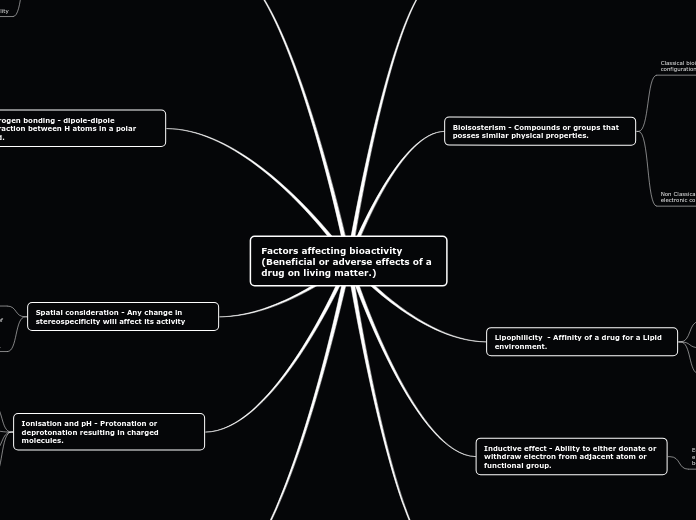Factors affecting bioactivity (Beneficial or adverse effects of a drug on living matter.)
Redox potential - Tendency that a compound has to give or recieve electrons.
Eg. Riboflavin, ε0 = -0.185 V shows its effect on living matter whereas Dichlororiboflavin, ε0 = -0.095 V cannot be used as a drug.
Bioisosterism - Compounds or groups that posses similar physical properties.
Classical bioisosteres - Similarities of shape and electronic configuration of atoms with which they are replaced.
Univalent atoms/groups such as Cl, Br, I etc
Bivalent atoms/groups such as R-O-R, R-S-R etc
Trivalents atoms/groups such as -P=, -N=
Tetravalent atoms/groups such as =C=, =N= etc
Ring equivalent atoms/groups
Eg. Replacement of -NH2 in Carbutamide
to -CH3 in Tolbutamide
Non Classical bioisosteres - Functional group with dissimilar electronic configuration.
Halogen
Catechol
Ether
Carbonil group
Hydroxil group
Eg. Ring VS Noncyclic structure of Diethylstilbestrol and 17-beta oectradiol.
Lipophilicity - Affinity of a drug for a Lipid environment.
Its measured as Partition coefficient or Distribution coefficient.
It is the result of intermolecular forces present in a solute and the two phases it partitions
Eg. CYP450 metabolism - Metabolic rate increases with increased Lipophilicity.
Inductive effect - Ability to either donate or withdraw electron from adjacent atom or functional group.
Eg. Penicillin V is superior to Penicillin G because it has electron withdrawing effect that allows Penicillium V to have better bioavailability.
Resonance - A way of describing a molecule having delocalized set of electrons which cannot be expressed by a single structure.
Drug having resonance will have its bioactivity being reduced or increased by another functional group.
Eg. Penicillin V has better bioavailability than Penicillin G as the ether oxygen on Penicillin V can be electron donating via resonance which is absent in Penicillin G.
Solubility- Drug must be in solution form before it is absorbed in the body to produce biological activity.
Factors affecting solubility
Particle size - As size decreases, solubility increases
Boiling and melting point - As MP/BP increases, solubility decreases
Temperature - As temperature increases, solubility increases
pH, Nature of solvent, Pressure, Common ion effect etc
Methods to improve solubility
Structural modifications
Use of cosolvents (Ethanol, Sorbitol)
Employing surfactants
Complexations
Hydrogen bonding - dipole-dipole interaction between H atoms in a polar bond.
Intermolecular H bonding - occurs between two or more molecules of same or different compound.
Intramolecular H bonding - occurs between two atom of the same molecules.
Eg. 1-phenyl 2,3- dimethyl 5- pyrazolone has analgesic activity and 1-phenyl- 3- methyl-5- pyrazolone is inactive.
Spatial consideration - Any change in stereospecificity will affect its activity
Optical isomers - Physical properties of both the enantiomers are identical. Eg. (R)-(+)-Thalidomide is a sedative whereas (S)-(-)-Thalidomide is a teratogen.
Geometric isomers - Physical properties of
both the enantiomers are different. Eg.
Cisplatin is a effective anti-cancer drug
whereas Transplatin is not effective at all.
Ionisation and pH - Protonation or deprotonation resulting in charged molecules.
The rate of drug absorption is directly proportional to the conc of the drug at absorbable form.
Ionization form imparts good water solubility to the drug which is required to binding of drug and receptor interaction.
Unionised form helps the drug to cross the cell membrane.
Eg. Phenytoin injection must be adjusted to pH 12 with sodium hydroxide to obtain 99.8% of the drug in ionised form.
Partition coefficient - Equilibrium constant of drug concentration for unionised molecule in two phases.
Affected by factors such as
pH
Cosolvents
Surfactants
Complexation
Eg. Phenobarbitone has a high lipid/water Partition coefficient whereas Thiopentone sodium has value about 100 and it is highly lipid soluble therefore used as ultra-short acting barbiturates.
